Egyptian Pound
The Egyptian pound (Egyptian Arabic: جنيه مصرى ; abbreviations: £, E£, £E, LE, or EGP in Latin, and ج.م.
It is divided into 100 piastres, or qirsh (قرش [ʔerʃ]; plural قروش [ʔʊˈruːʃ]; abbreviation: PT (short for "piastre tarif")), or 1,000 milliemes (مليم [mælˈliːm]; French: millième, abbreviated to m or mill), but milliemes are no longer used.
| جنيه مصرى (Egyptian Arabic) | |||||
|---|---|---|---|---|---|
| |||||
| ISO 4217 | |||||
| Code | EGP (numeric: 818) | ||||
| Subunit | 0.01 | ||||
| Unit | |||||
| Symbol | £, E£, £E, LE, EGP, .ج.م | ||||
| Denominations | |||||
| Subunit | |||||
| 1⁄100 | Piastre (قرش, "qirsh") | ||||
| 1⁄1,000 | Millieme (مليم, mallīm) Milliemes are obsolete. | ||||
| Banknotes | |||||
| Freq. used | £5, £10, £20, £50, £100, £200 | ||||
| Rarely used | 25 PT, 50 PT, £1 | ||||
| Coins | 25 PT, 50 PT, £1 | ||||
| Demographics | |||||
| Date of introduction | 1834 | ||||
| Replaced | Egyptian piastre | ||||
| Official user(s) | |||||
| Unofficial user(s) | |||||
| Issuance | |||||
| Central bank | Central Bank of Egypt | ||||
| Website | www | ||||
| Valuation | |||||
| Inflation | 8.496% (2022) | ||||
The new 10- and 20-pound notes are made out of polymer plastic paper as of July 6, 2022.

History
In 1834, a khedival decree was issued, adopting an Egyptian currency based on a bimetallic standard (gold and silver) on the basis of the Maria Theresa thaler, a popular trade coin in the region. The Egyptian pound, known as the juneih, was introduced, replacing the Egyptian piastre (qersh) as the chief unit of currency.
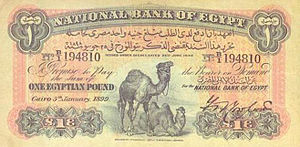
The piastre continued to circulate as 1⁄100 of a pound, with the piastre subdivided into 40 para. In 1885, the para ceased to be issued, and the piastre was divided into tenths (عشر القرش 'oshr el-qirsh). These tenths were renamed milliemes (malleem) in 1916. The legal exchange rates were fixed by force of law for important foreign currencies which became acceptable in the settlement of internal transactions. Eventually this led to Egypt using a de facto gold standard between 1885 and 1914, with E£1 = 7.4375 grammes pure gold. At the outbreak of World War I, the Egyptian pound used a sterling peg of one pound and sixpence sterling to one Egyptian pound. Inverted, this gives E£0.975 for one pound sterling.
Egypt remained part of the sterling area until 1962, when Egypt devalued slightly and switched to a peg to the United States dollar, at a rate of E£1 = US$2.3. This peg was changed to E£1 = US$2.55555 in 1973 when the dollar was devalued. The Egyptian pound floated in 1989. However, until 2001, the float was tightly managed by the Central Bank of Egypt and foreign exchange controls were in effect. After exhausting all of its policies to support the pound, the Central Bank of Egypt was forced to end the managed-float regime and allowed the currency to float freely on 3 November 2016; the bank also announced an end to foreign exchange controls that day. The official rate fell twofold.
In 2023, the Egyptian government reimplemented foreign exchange controls, leading to black market exchange rates for the pound up to two times higher (74:1) than the official rate (30.9:1) in February 2024. The pound was floated again on March 6, 2024, causing the official exchange rate to plummet by 40% against the US dollar.
Egyptian pound in outside Egypt

The Egyptian pound was also used in Anglo-Egyptian Sudan between 1899 and 1956, and Cyrenaica when it was under British occupation and later an independent emirate between 1942 and 1951. It also circulated in Mandatory Palestine from 1918 to 1927, when the Palestine pound was introduced, equal in value to the pound sterling. The National Bank of Egypt issued banknotes for the first time on 3 April 1899. The Central Bank of Egypt and the National Bank of Egypt were unified into the Central Bank of Egypt in 1961.
Nomenclature
Used for historical values or in vernacular speech
Several unofficial popular names are used to refer to different denominations of Egyptian currency. These include (from the word nickel) nekla (نكلة) [ˈneklæ] for 2 milliemes, ta'rifa (تعريفة) [tæʕˈriːfæ] for 5 milliemes,
"nos franc" (نص فرانك) for 2 piastres, shelen (شلن) [ˈʃelen] (i.e. a shilling) for 5 piastres, bariza (بريزة) [bæˈriːzæ] for 10 piastres, and reyal (ريال) [reˈjæːl] ("real") for 20 piastres.
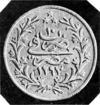
Since the piastre and millieme are no longer legal tender, the smallest denomination currently minted being the 25 PT coin (functioning as one-quarter of E£1), these terms have mostly fallen into disuse and survive as curios. A few have survived to refer to pound notes: bariza now refers to the E£10 note and reyal can be used in reference to the E£20 note.[citation needed]
Informal
Different sums of the Egyptian pound have nicknames in vernacular speech, for example: E£1 bolbol (بلبل) "nightingale" or gondi (جندى) "soldier"; E£1,000 bako (باكو) [ˈbæːko] "pack"; E£1,000,000 arnab (أرنب) [ˈʔærnæb] "rabbit"; E£1,000,000,000 feel (فيل) [fiːl] "elephant".[citation needed]
Coins
Between 1837 and 1900, copper 1 and 5 para*, silver 10 and 20 para, 1, 5, 10 and 20 piastre (pt), gold 5pt, 10pt. and 20pt and E£1 coins were introduced, with gold 50 PT coins issued in 1839.
Copper 10 para coins were introduced in 1853, although the silver coin continued to be issued. Copper 10 para coins were again introduced in 1862, followed by copper 4 para and 21⁄2 PT coins in 1863. Gold 25 PT coins were introduced in 1867.
In 1885, the para was replaced by the millieme in order to decimalise the currency and a new coinage was introduced. The issue consisted of bronze 1⁄4, 1⁄2, 1, 2 and 5 millieme (m), silver 1 PT, 2 PT, 5 PT, 10 PT and 20 PT coins. The gold coinage practically ceased, with only small numbers of 5 PT and 10 PT coins issued.

In 1916 and 1917, a new base metal coinage was introduced consisting of bronze 1⁄2m and holed, cupro-nickel 1m, 2m, 5m and 10m coins. Silver 2 PT, 5 PT, 10 PT and 20 PT coins continued to be issued, and a gold E£1 coin was reintroduced. Between 1922 and 1923, the gold coinage was extended to include 20 PT and 50 PT and E£1 and E£5 coins. In 1924, bronze replaced cupro-nickel in the 1m coin and the holes were removed from the other cupro-nickel coins. In 1938, bronze 5m and 10m coins were introduced, followed in 1944 by silver, hexagonal 2 PT coins.
Between 1954 and 1956, a new coinage was introduced, consisting of aluminium-bronze 1m, 5m and 10m and silver 5 PT, 10 PT and 20 PT coins, with the size of the silver coinage significantly reduced. An aluminium-bronze 2m coin was introduced in 1962. In 1967 the silver coinage was abandoned and cupro-nickel 5 and 10 piastre coins were introduced.
Aluminium replaced aluminium-bronze in the 1m, 5m and 10m coins in 1972, followed by brass in the 5m and 10m coins in 1973. Aluminium-bronze 2 PT and cupro-nickel 20 PT coins were introduced in 1980, followed by aluminium-bronze 1 PT and 5 PT coins in 1984. In 1992, brass 5 and 10 piastre coins were introduced, followed by holed, cupro-nickel 25 piastre coins in 1993. The size of 5 PT coins was reduced in 2004, 10 PT and 25 PT coins - in 2008.
On the 1st of June, 2006, 50 PT and E£1 coins dated 2005 were introduced, and its equivalent banknotes were temporarily phased out from circulation in 2010. The coins bear the face of Cleopatra VII and Tutankhamun's mask, and the E£1 coin is bimetallic. The size and composition of 50 PT coins was reduced in 2007.
| Value | Debut | Image | Specifications | Description | ||||||
|---|---|---|---|---|---|---|---|---|---|---|
| Obverse | Reverse | Diameter (mm) | Thickness (mm) | Mass (g) | Composition | Obverse | Reverse | |||
| 5 PT** | 1984 |  |  | 23 | 1.2 | 4.9 | Copper 95% Aluminium 5% | 3 pyramids of Giza |
| |
| 1992 | 21 | 1.1 | 3.2 | Copper 92% Aluminium 8% | Islamic pottery | |||||
| 2004–2008 | 17 | 1.04 | 2.4 | Steel 94% Nickel 2% Copper plating 4% | ||||||
| 10 PT** | 1984 | 25 | 1.35 | 5.2 | Copper 75% Nickel 25% | Mosque of Muhammad Ali | ||||
| 1992 |  |  | 23 | 1.2 | 4.9 | Copper 95% Aluminum 5% | ||||
| 2008 | 19 | 1.1 | 3.2 | Steel 94% Copper 2% Nickel plating 4% | ||||||
| 20 PT** | 1984 | 27 | 1.4 | 6 | Copper 75% Nickel 25% | |||||
| 1992 |  | 25 | 1.35 | 5.2 | Copper 95% Aluminium 5% | Al-Azhar mosque | ||||
| 25 PT | 1993** | 1.4 |
| |||||||
| 2008-22 | 21 | 1.26 | 4.5 | Steel 94% Copper 2% Nickel plating 4% | ||||||
| 50 PT | 2005 |  |  | 25 | 1.58 | 6.5 | Copper 75% Zinc 20% Nickel 5% |
| ||
| 2007-21 | 23 | 1.7 | Steel 94% Nickel 2% Copper plating 4% | |||||||
| £1*** | 2005 |  |  | 25 | 1.89 | 8.5 | Bimetal | Tutankhamun's mask |
| |
| Ring | Centre | |||||||||
| Copper 75% Nickel 25% | Copper 75% Zinc 20% Nickel 5% | |||||||||
| 2007–2022 | 1.96 | Steel 94% Copper 2% Nickel plating 4% | Steel 94% Nickel 2% Copper plating 4% | |||||||
** Not in circulation as of 2008.
*** As to commemorate the branching of the Suez canal, the obverse had the Arabic phrase, قناة السويس الجديدة "New Suez Canal".Banknotes
In 1899, the National Bank of Egypt introduced notes in denominations of 50 PT, £1, £5, £10, £50 and £100. Between 1916 and 1917, 25 PT notes were added, together with government currency notes for 5 PT and 10 PT issued by the Ministry of Finance.
In 1961, the Central Bank of Egypt took over from the National Bank and issued notes in denominations of 25 and 50 piastres, £1, £5, £10 and £20 notes were introduced in 1976, followed by £100 in 1978, £50 in 1993 and £200 in 2007.


All Egyptian banknotes are bilingual, with Arabic texts and Eastern Arabic numerals on the obverse, and English texts and Western Arabic numerals on the reverse. Obverse designs tend to feature an Islamic building with reverse designs featuring Ancient Egyptian motifs (buildings, statues and inscriptions). During December 2006, it was mentioned in articles in Al Ahram and Al Akhbar newspapers that there were plans to introduce £200 and £500 notes. As of 2019, there are £200 notes circulating but there are still no plans for issuing £500 notes. Starting from 2011 the 25 PT, 50 PT and £1 banknotes were phased out in favour of more extensive use of coins. However, as of June 2016 the National Bank of Egypt reintroduced the £1 banknote into circulation as well as 25 PT and 50 PT notes in response to a shortage of small change.
The governor of the Central Bank of Egypt announced that the Central Bank of Egypt will issue polymer notes by the beginning of 2021. This change comes as the CBE moves its headquarters to the new administrative capital. On July 31, 2021, the President of Egypt reviewed the notes of £10 and £20, to be issued in November 2021. In August 2021, the Central Bank was forced to confirm that rainbow holograms on the new banknotes were a secure watermarking feature to prevent counterfeiting, after online critics suggested it was a covert message of support for LGBT rights. Just nearly 2 years after the £10 note was released, the Central Bank of Egypt released the new £20 polymer banknote. The paper variants of the same denominations will continue to be legal tender.
| Image | Value | Dimensions (millimeters) | Main color | Description | Year of first issue | ||
|---|---|---|---|---|---|---|---|
| Obverse | Reverse | Obverse | Reverse | ||||
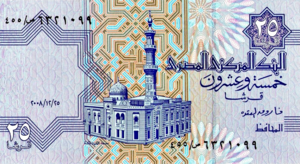 | 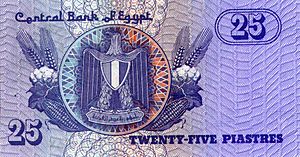 | 25 PT | 130 × 70 | Blue | Ayesha mosque | Coat of arms of Egypt | 1985 |
 |  | 50 PT | 135 × 70 | Brown/yellow-green | Al-Azhar Mosque | Ramesses II | 1985 |
 |  | £1 | 140 × 70 | Beige | Mosque and mausoleum of Qaitbay | Abu Simbel temples | 1978 |
 |  | £5 | 145 × 70 | Bluish-green | Mosque of Ibn Tulun | A Pharaonic engraving of Hapi (god of the annual flooding of the Nile) offering bounties. | 1981 |
 |  | £10 | 132 × 69 | Orange | Al-Fattah Al-Aleem Mosque | Hatshepsut | 2022 |
 |  | £20 | 137 × 69 | Mint Green | Mosque of Muhammad Ali | A Pharaonic war chariot and Queen Cleopatra | 2023 |
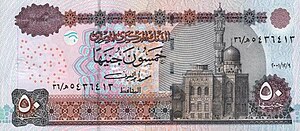 |  | £50 | 160 × 70 | Brownish-red | Abu Hurayba Mosque | Temple of Edfu | 1993 |
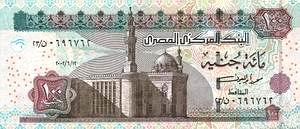 |  | £100 | 165 × 70 | Cyan | Sultan Hassan Mosque | Great Sphinx of Giza | 1994 |
 | 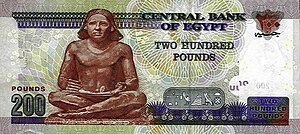 | £200 | 165 × 72 | Olive | Mosque of Qani-Bay | The Seated Scribe | 2007 |
Historical and current exchange rates
This section possibly contains original research. (September 2023) |
Sterling
This table shows the value of 1 pound sterling in Egyptian pounds:
| Date | Official rate |
|---|---|
| 1885 to 1949 | E£0.975 |
| 2008 | E£10.0775 |
| 2009 | E£8.50 |
| 2012 | E£9.68 |
| 2014 | E£11.97 to E£12.03 |
| 2016 | E£12.60 to E£21.21 |
| 2017 | E£20.00 |
| 2020 | E£20.00 |
| 2022 | E£29.90 as of the end of the year |
| 2023 | E£39.31 as of November 29 |
US dollar

This table shows the historical value of US$1 in Egyptian currency (piastres prior to 1834, pounds thenceforth):
| Date | Official rate |
|---|---|
| 1789 to 1799 | E£0.03 (3 PT) |
| 1800 to 1824 | E£0.06 (6 PT) |
| 1825 to 1884 | E£0.14 (14 PT) |
| 1885 to 1939 | E£0.20 |
| 1940 to 1949 | E£0.25 |
| 1950 to 1967 | E£0.36 |
| 1968 to 1978 | E£0.40 |
| 1979 to 1988 | E£0.60 |
| 1989 | E£0.83 |
| 1990 | E£1.50 |
| 1991 | E£3.00 |
| 1992 | E£3.33 |
| 1993 to 1998 | E£3.39 |
| 1999 | E£3.40 |
| 2000 | E£3.42 to E£3.75 |
| 2001 | E£3.75 to E£4.50 |
| 2002 | E£4.50 to E£4.62 |
| 2003 | E£4.82 to E£6.25 |
| 2004 | E£6.13 to E£6.28 |
| 2005 to 2006 | E£5.75 |
| 2007 | E£5.640 to E£5.50 |
| 2008 | E£5.50 to E£5.29 |
| 2009 | E£5.75 |
| 2010 | E£5.80 |
| 2011 | E£5.95 |
| 2012 | E£6.36 |
| 2013 | E£6.50 to E£6.96 |
| 2014 | E£6.95 to E£7.15 |
| 2015 | E£7.15 to E£11.00 |
| 2016 | E£15.00 to E£18.00 |
| 2017 | E£17.70 to E£17.83 |
| 2018 | E£17.69 to E£17.89 |
| 2019 | E£17.89 to E£15.99 |
| 2020 | E£16.04 to E£15.79 |
| 2021 | E£15.82 to E£15.71 |
| 2022 | E£15.72 to E£24.70 |
| 2023 | E£24.75 to E£30.95 parallel rate up to E£53 |
See also
| Current EGP exchange rates | |
|---|---|
| From Google Finance: | AUD CAD CHF CNY EUR GBP HKD JPY USD ILS JOD TRY |
| From Yahoo! Finance: | AUD CAD CHF CNY EUR GBP HKD JPY USD ILS JOD TRY |
| From XE.com: | AUD CAD CHF CNY EUR GBP HKD JPY USD ILS JOD TRY |
| From OANDA: | AUD CAD CHF CNY EUR GBP HKD JPY USD ILS JOD TRY |
References
Bibliography
- Krause, Chester L.; Clifford Mishler (1991). Standard Catalog of World Coins: 1801–1991 (18th ed.). Krause Publications. ISBN 0873411501.
- Pick, Albert (1994). Standard Catalog of World Paper Money: General Issues. Colin R. Bruce II and Neil Shafer (editors) (7th ed.). Krause Publications. ISBN 0-87341-207-9.
External links

|}
This article uses material from the Wikipedia English article Egyptian pound, which is released under the Creative Commons Attribution-ShareAlike 3.0 license ("CC BY-SA 3.0"); additional terms may apply (view authors). Content is available under CC BY-SA 4.0 unless otherwise noted. Images, videos and audio are available under their respective licenses.
®Wikipedia is a registered trademark of the Wiki Foundation, Inc. Wiki English (DUHOCTRUNGQUOC.VN) is an independent company and has no affiliation with Wiki Foundation.







